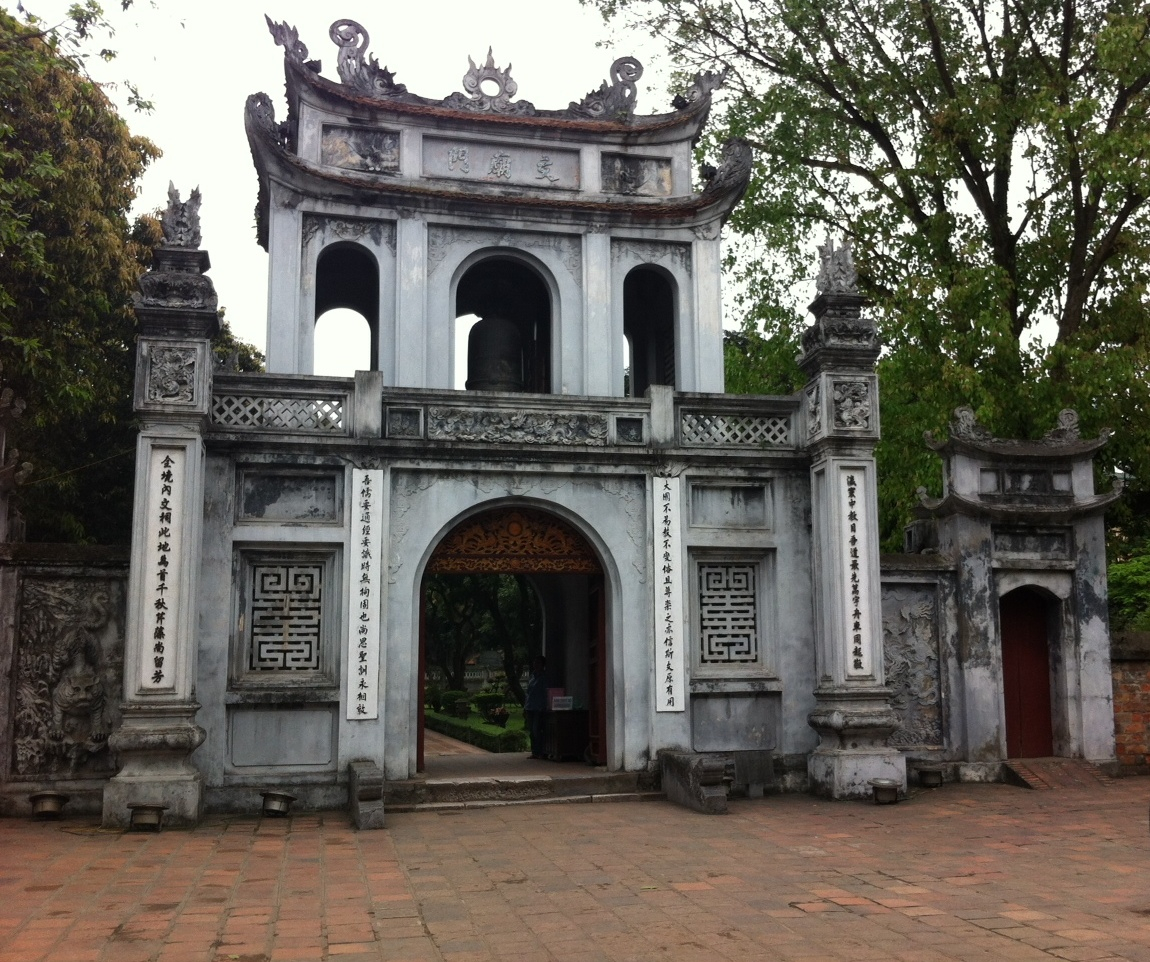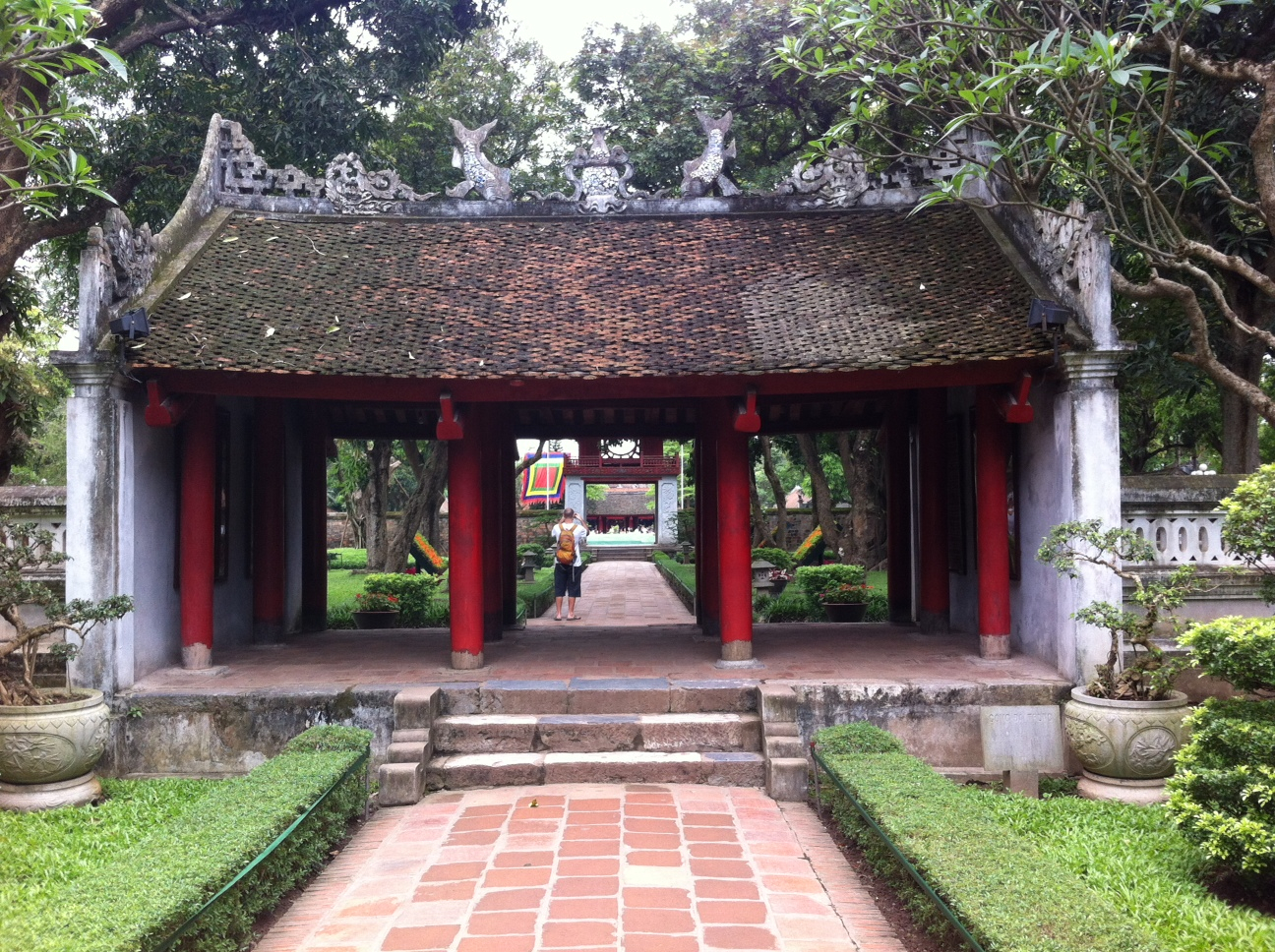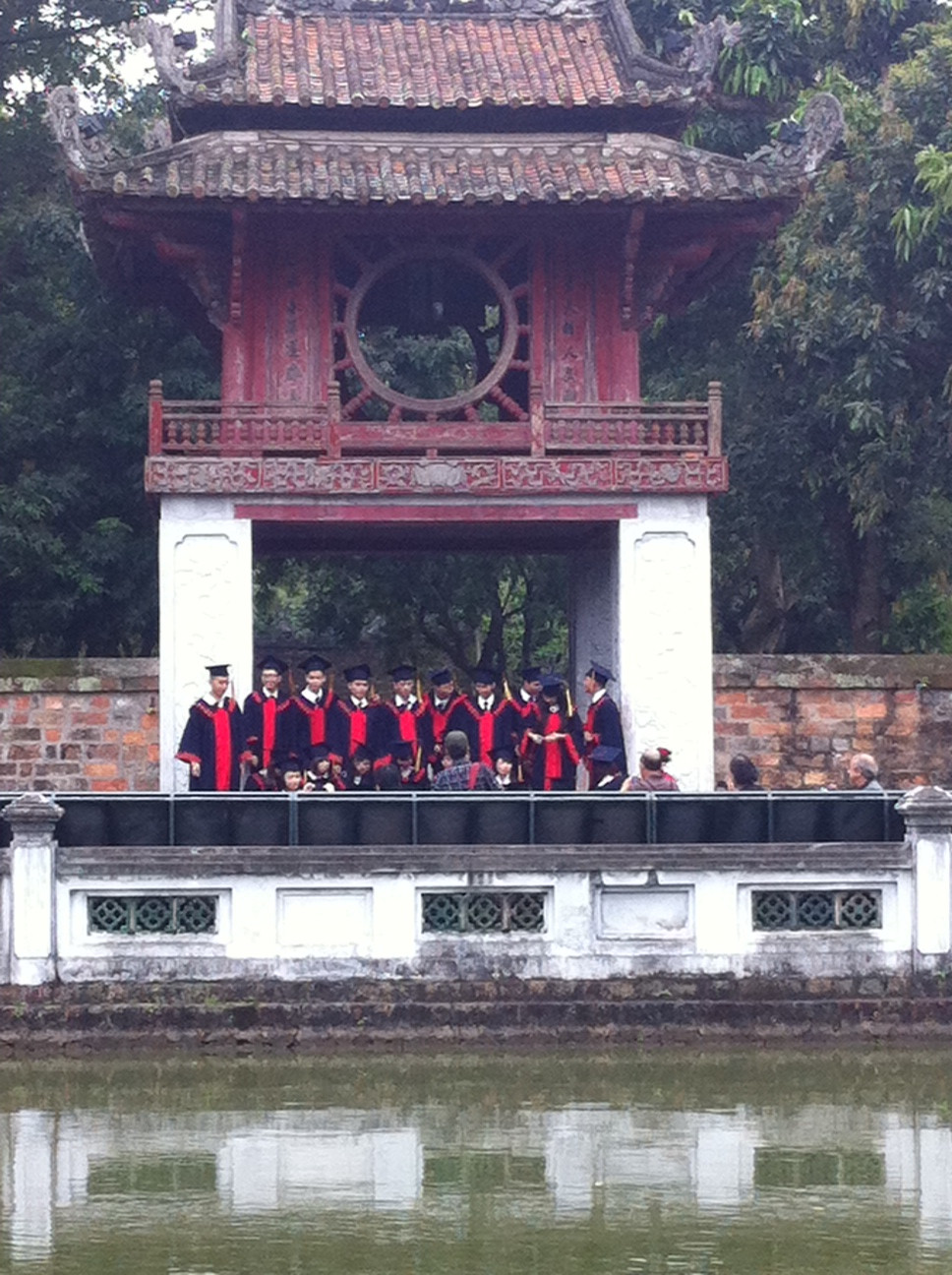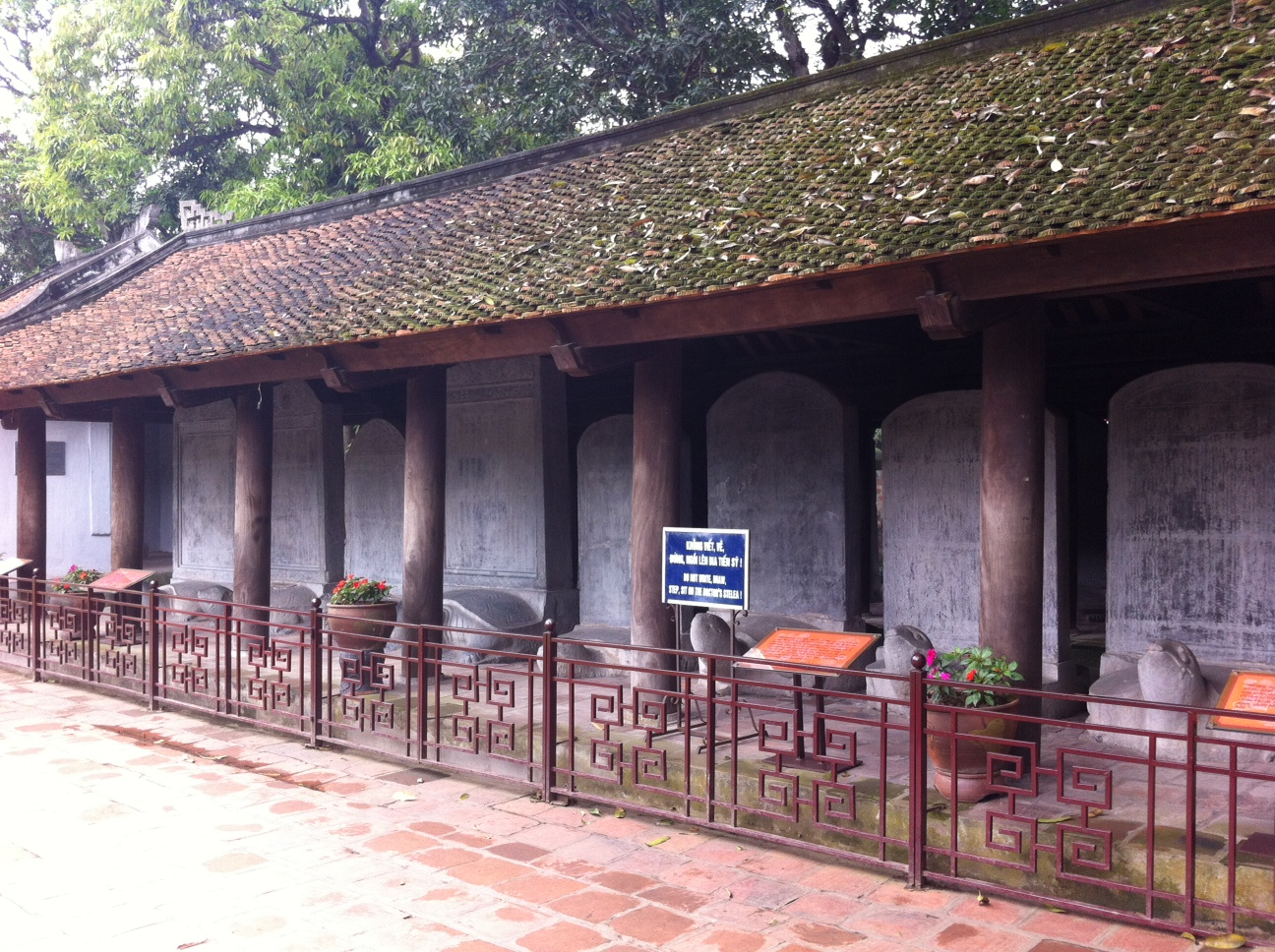
By Catherine Clover –
Spring Morning
In the hut in the mountains one is free the live-long day
A clump of bamboos leaning o’er screens from cold mountain air
Green grows the grass and the sky reels in joy,
Late lingers the dew in the cups of scarlet flowers
The man alone with the lonely cloud clings to the mountainside
His spirit like water in old wells lies still, unshaken by any tremor
As the sweet pine logs sink to ash the pot for tea stops boiling
A murmur of birds from the depths of the ravine brings him back
from the light sleep of Spring
-Poet and Scholar Chu VănAn (1292-1370)
14th Century Rector of the Quôc TÚ Giám (or, the Royal College at Văn Miếu )[1]
On a recent trip to Hanoi, I was pleasantly surprised to discover it is a small city full of history and rich in cultural attractions. My preconceived ideas of what I might see and feel upon making the journey were all quickly dispelled as the taxi motored me from the airport into the central part of old Hanoi.
Friends who had visited the city before me had all extolled the incredible war propaganda on display from the Vietnam War and remnants of the period of French Colonization. I chose to be free from visiting historical monuments or museums with an overtly critical anti-American and anti-colonial feel. Instead I wished to embrace the colonial architecture that is so distinct and well preserved in Hanoi. I sought the beauty of the city that is found in the many public parks and monuments of historical significance to the Vietnamese. Hanoi offers the visitor plenty of these.
A monument in Hanoi that well represents the history and culture of the people is the Van Mieu, or the Temple of Literature. In 1070 AD the foundation was laid for teaching literature to the aristocracy, and later included instruction for future rulers and leaders, in the north at Van Mieu. In the Vietnamese language the concept of literature encompasses culture and peace. These attributes perfectly describe the setting of the Temple of Literature.
On a journey through the Temple, the visitor passes through five courtyards, each one unique from the others and each one representing the traditional Chinese classification of nature – metal, wood, water, fire and earth[2]. The quiet, serene beauty of the Temple moved me. Set as it is amidst the noise and rush of busy city streets with motorcycles, cars, rickshaws and street vendors pulling their carts, once inside the sacred walls of the Temple, the secular world around me fell silent and a deep calm ensued. The meticulously manicured gardens in each courtyard are reminiscent of the beautiful and harmonious gyoen, or gardens, of Japan. I was left to wander through the courtyards in my own thoughts and contemplate their significance along the way.

In the 11th century the site was located outside the city walls, among the rice paddies and the north shore of a large lake [3]. With the expansion of the city as it enveloped the countryside, the Temple today is located near the heart of old Hanoi. It sits among the leafy streets with a backdrop of low -rise modern structures and shop houses bordering it. Over the centuries parts of the Temple have been rebuilt and additions made so that the current parallelogram design most closely resembles the Temple of Confucius in Qufu, China[4]. Through the early 20th century, the Vietnamese paid close allegiance to Chinese culture[5], in particular, to Confucianism, even after the study of Confucianism was no longer allowed in China in 1905[6].

Though the royal college was later moved to the city of Hue outside Hanoi in the nineteenth century, the buildings and their relevant history remained an important facet of Hanoi’s prominence and identity. The royal college was initially comprised of only two courtyards, which today are courtyards number three, called Garden of the Stelae, and four, called Courtyard of the Sages. The original plan for the additional three later courtyards called for a hedge to separate them[7]. Later, the hedges were replaced with brick walls taken from the Hanoi Citadel in the 19th century after its reconstruction [8]. The first two courtyards, called Entrance to the Way and Great Middle Courtyard respectively, and their decorative gates are 18th century additions. A main pathway connects all the courtyards, and visitors must pass through a series of parallel gates as they make their way steadily onwards towards the fifth and final courtyard, one dedicated to the pinnacle of knowledge, called Quôc TÚ Giám, or School for the Sons of the Nation[9]. The buildings in the fifth courtyard were rebuilt after being mistakenly shelled by the French in 1947.
While the Temple of Literature was originally founded to educate members of the Vietnamese royal family and later the aristocratic mandarins, eventually admission was opened to those who could pass regional examinations. To complete a doctorate in literature was by no means an easy feat. Thousands of scholars ranging in age from 16 to 61 attended the royal examinations during the period 1442-1779, and today 1,306 names are recorded on the 82 stelae in courtyard four[10]. The examination took several months and was given in multiple stages once every three years. Ultimately the exams centered on answering questions relating to many different topics including pre-Confucian and Confucian works, matters pertaining to the state drawing upon knowledge of classical literature and history and even writing using the poetic style of Tho PhÚ[11]. The poems that were written by former academics at Văn Miếu are beautiful in their descriptive language and observation of nature. The stelae bearing the names of those who were conferred as doctors were buried during the Vietnam War in the 1960s to protect them. However, laying in the elements for several decades left the stelae in a serious state of decay. Through a joint funded project in 1993-4, the stelae were cleaned and restored and new pavilions were built to house them. The two groups responsible for the project were the Ministry of Culture and Information of Vietnam and the American Express Foundation, with administrative support from the U.S. Indochina Reconciliation Project[12]. In 2010 UNESCO recognized the stelae as World Documentary Heritage. They stand today as a testament of what good can come about from the ravages of war on historical monuments.
On the day of my visit, my excursion was further heightened with the presence of university graduates in their cap and gowns, taking class photos in the different courtyards of the temple of literature. Not a stranger to academic settings, I felt proud for them as I watched them assemble for their photos. I felt I had a rare glimpse of the hope and future of Vietnam.

Improvisation
Loitering in the evening I contemplate the world,
the instant of a bird’s flight. These hills, high or low,
are measured by the clouds. These trees, supple or straight,
are tested by the wind. A thousand autumns gone,
Thousand generations gazing at the moon,
yet still herself. Everything is known
Only the human heart remains unfathomed.
Nguyễ Trãi
15th century mandarin scholar from Văn Miếu [13]
Notes:
[1] Bogan, Diane, et al., Van Mieu, A Walking Tour: Temple of Literature, School for the Sons of the Nation in Hanoi, Hanoi, 2010, 35
[2] Op. cit., 4
[3] Op. cit., 5
[4] This is the oldest Confucian temple in China. It was built in 478 BC at Confucius’ birthplace. Bogan, op. cit., 4
[5] For more reading on the influence of Chinese culture in Vietnam, see Huard, Pierre and Maurice Durand, Viet Nam, Civilization and Culture, Hanoi, 25
[6] Chi, Hoang Van, From Colonialism to Communism: A Case History of North Vietnam, 1964, London, 7
[7] Bogan, op. cit., 7
[8] Op. cit., 29
[9] Bogan, op. cit., 8
[10] Op. cit., 37
[11] Op. cit., 36. Bogan describes the Tho PhÚ as “a poem of 28 words, divided into four lines of seven-words, the phÚ a prose poem of 8 seven-word lines”.
[12] Op. cit., 36
[13] Op. cit., 13